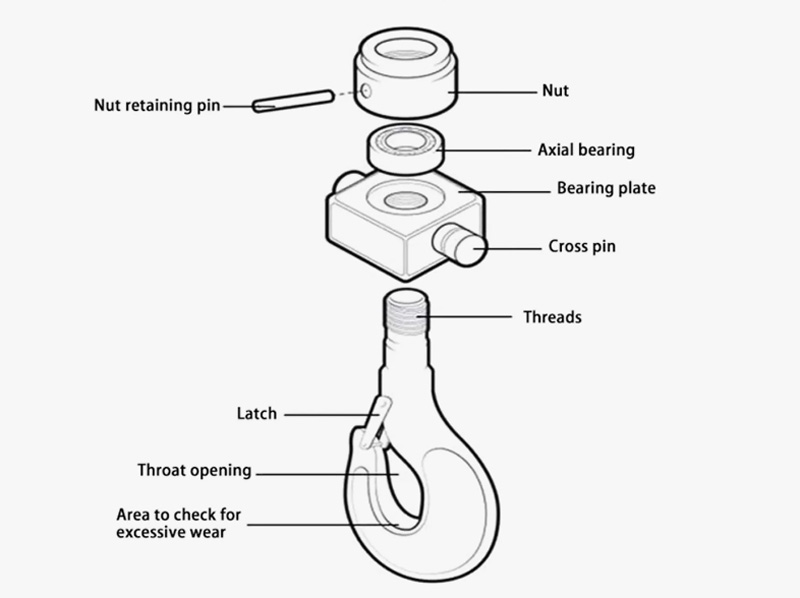Cuando pensamos en grúas, La estructura imponente o el poderoso cabrestante a menudo viene a la mente. Pero posiblemente el componente más crítico y con frecuencia se pase por alto es el humilde gancho. Es el enlace final en la cadena de levantamiento, el punto donde el poder de la grúa se encuentra con la carga. Comprender su anatomía no es solo jerga técnica; Es fundamental para operaciones de elevación seguras y eficientes. Desglosemos las partes clave de un gancho de grúa:

El gancho (o cuerpo de gancho):
Que es: La parte curva icónica diseñada para mantener hondas de forma segura, grilletes, o cunar directamente la carga.
Función: Proporciona el punto principal de unión y superficie de rodamiento para la carga. Su forma (a menudo una "c" o "u" profunda) está diseñado para evitar que la carga se deslice bajo tensión.
Característica clave: La abertura de la garganta es la distancia entre el punto de gancho y el vástago (vea abajo). Determina el tamaño máximo de esling o accesorio que se puede usar.
El punto (o propina):
Que es: El extremo de la curva de gancho.
Función: Mientras que no la superficie de carga primaria de carga, Debe ser suave y libre de muescas o grietas para evitar hondas dañinas. Su forma ayuda a guiar eslings al gancho.
El vástago (o curva):
Que es: El grueso, derecho(ish) Sección que conecta la curva de gancho al ojo o la porción roscada. Esta es la parte más fuerte del gancho.
Función: Lleva la mayoría de la tensión de tracción generada por la carga. Su sección transversal está diseñada para manejar la capacidad de carga nominal.
El ojo (o corona):
Que es: El reforzado, Sección superior redondeada del gancho donde se conecta al bloque de gancho o al sistema de suspensión.
Función: Proporciona una superficie de rodamiento lisa para el mecanismo giratorio (Si está presente) o el pin/enlace de suspensión. Está diseñado para manejar las fuerzas de compresión y de corte..
El giro (Opcional pero común):
Que es: Un conjunto de cojinetes integrado entre el ojo del gancho y el enlace de suspensión/grillete.
Función: Permite el gancho (y la carga) para girar libremente bajo carga. Esto evita la torsión de las hondas de carga y la cuerda de alambre, Reducir significativamente el desgaste y hacer que el posicionamiento de carga sea más fácil y más seguro. Consiste en carreras internas y externas con rodamientos.
El enlace de suspensión / Ojo de grillete:
Que es: El punto sobre el ojo del gancho o giratorio donde el conjunto del gancho se conecta al bloque de carga inferior de la grúa (a través de un alfiler o grillete).
Función: Proporciona el punto de fijación al mecanismo de elevación. A menudo presenta un orificio grande o orificio.
El pestillo (Patch de seguridad o clip de gancho):
Que es: Una puerta o clip de resorte que cubre la abertura de la garganta del gancho.
Función: Crucial por seguridad! Preventa las eslingas, cadenas, u otros accesorios de deslizar o "saltar" accidentalmente del punto de gancho durante la operación, Especialmente si ocurre la holgura. Nunca derrote a un pestillo de seguridad!
Tipos: Los tipos comunes incluyen pestillos de primavera (de cierre automático) y pestillos de guardián (Operación manual pero segura).
La garganta:
Que es: El área abierta dentro de la curva del cuerpo del gancho, Limitado por el vástago y el punto.
Función: Aquí es donde se encuentra el accesorio de la esling o la carga. El punto de rodamiento de carga es el área específica en el interior del vástago donde descansa principalmente la carga..
La silla (o asiento):
Que es: El específico, Área ligeramente aplanada en el interior del vástago, Frente al punto.
Función: El punto de contacto principal diseñado para soportar el peso de la carga. Debe ser suave y libre de daños. Las hondas siempre deben asentarse correctamente contra la silla.

Seguridad: Comprender la estructura del gancho ayuda a identificar puntos de desgaste críticos (como la silla o el pestillo) Durante las inspecciones. Reconocer daños previene una falla catastrófica.
Inspección: Riggers e inspectores saben exactamente dónde buscar grietas, deformación, tener puesto, o mal funcionamiento del pestillo (Las regulaciones de ASME B30.10 y OSHA exigen inspecciones regulares).
Uso adecuado: Conociendo el punto de carga de la carga (sillín) Asegura que las hondas estén correctamente sentadas. Comprender la abertura de la garganta evita el uso de archivos adjuntos de gran tamaño.
Comunicación: El uso de la terminología correcta garantiza una comunicación clara entre los operadores, aparejo, y personal de mantenimiento.
Obtención: Asegura que solicite las piezas de repuesto correctas (P.EJ., un pestillo específico o un conjunto giratorio).
El gancho es una maravilla de la ingeniería enfocada. Cada parte juega un papel distinto y vital para transferir de manera segura las cargas inmensas. Desde la robusta tensión de manejo de vástagos hasta el pestillo que salva la vida que protege la garganta, Comprender estos componentes no es negociable para cualquier persona involucrada en las operaciones de levantamiento. Nunca subestimes la importancia de inspeccionar y mantener esta pieza crítica de hardware: la integridad de tu ascensor, y potencialmente vive, depender de ello.
Valoramos sus comentarios! Complete el formulario a continuación para que podamos adaptar nuestros servicios a sus necesidades específicas..


Haga clic en el botón para obtener información del producto y cotizaciones en WhatsApp.
Obtener una cotización
Últimos comentarios